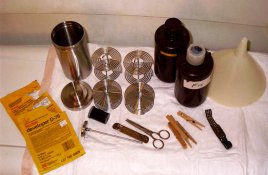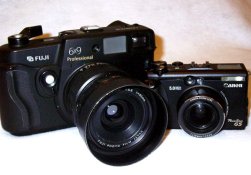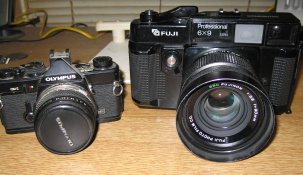the.ronin
Member
- Joined
- Feb 20, 2013
- Messages
- 2
- Format
- Med. Format RF
I finally won an auction for a medium format film camera - a Fuji GSW 690II SW for $445. I am particularly excited because I had honed in on the Fuji line of MF cameras but was always outbid. This was a little more than I was willing to pay (wanted to keep it sub $400) but my sense is, assuming this camera is in good condition, this is a decent price.
I've used strictly DSLR (Nikon D40 and now a D90) as a hobbyist but my wife started getting into film as part of formal photography classes. I researched a bit into film and was blown away by the quality larger format cameras are capable of capturing. In general, the Fuji line seemed to be the most compact and accessible and, not the least of which, far more affordable.
Unfortunately, the shipper is doing what I think is parcel post so it may take upwards of a month to get here LOL. In the meantime I wanted to do as much research as I could.
Some questions I had if anybody could provide some guidance:
1) Light metering
2) Film
3) Developing
4) Scanning
5) Bag
I've used strictly DSLR (Nikon D40 and now a D90) as a hobbyist but my wife started getting into film as part of formal photography classes. I researched a bit into film and was blown away by the quality larger format cameras are capable of capturing. In general, the Fuji line seemed to be the most compact and accessible and, not the least of which, far more affordable.
Unfortunately, the shipper is doing what I think is parcel post so it may take upwards of a month to get here LOL. In the meantime I wanted to do as much research as I could.
Some questions I had if anybody could provide some guidance:
1) Light metering
I understand this line of cameras has no light meter. I know I could use the meter in my DSLR set to manual but I foresee my using the MF in times when I might not even carry around the DSLR. Any recommendations on an affordable / entry level light meter?
2) Film
Any recommendations on color and BW film for the Fuji GSW 690II SW? I will likely use 120s equally for the price and the forced discipline of fewer exposures per roll. (Wow this is going to be such a change from my DSLR!!)
3) Developing
If possible I would like to minimize the cost of developing film. I would anticipate having colored film developed at a lab given how involved it is. However, I would consider developing BW at home. Any issues I should consider?
4) Scanning
I definitely would consider scanning negatives at home and saving them as TIFF (which I understand preserves the greatest amount of range in the shot). For this, I've been eyeing the CanoScan 9000F. I've read that the Nikon Coolscan scanners are of particularly great quality but just way outside of my price range. From the TIFFs, I plan to export to JPG for online publishing or print to photo paper using an Epson Artisan 710. Again, any recommendations on this setup would be appreciated.
5) Bag
How do you folks carry this brick? LOL







 but if I intend to pack it on a short hike or on an airplane I put it in a small backpack.
but if I intend to pack it on a short hike or on an airplane I put it in a small backpack.
